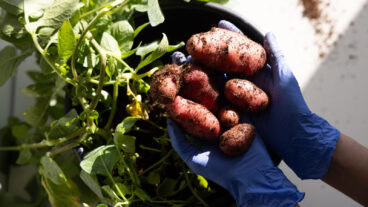Prof. Alexander Vainstein: Smell is not only what you smell with your nose, but also what you taste.Prof. Alexander Vainstein is proud of his greenhouses. Located at the Hebrew University’s Robert H. Smith Institute of Plant Sciences and Genetics in Agriculture in Rehovot, these greenhouses offer visitors both a delight to the senses, and a trip to a futuristic world where flowers emerge in different colors, with different scents, and a whole new genetic make-up designed to enhance and improve the flower stock.
“You’ll see types of flowers in our greenhouses that do not exist anywhere else in the world,” says Vainstein, the head of the institute, with satisfaction. “People are stunned at what we are doing here. We have petunias, which traditionally don’t have a smell, giving off such a strong perfume that it overpowers you as you walk through the greenhouse doors.”
The greenhouses are only a small part of Vainstein’s work, however. Back in the lab, he and other researchers from the Faculty of Agricultural, Food and Environmental Quality Sciences have discovered how to insert the scent of flowers into different foods, how to intensify the smell of perfumes and creams, and how to create a natural scent with nothing more than a Petri dish.
The developments, which use the same genetic engineering techniques developed in the human genome project to enhance the shape, color and smell of flowers, have generated a great deal of interest from the chemical, food and flower industries, which are not only following developments, but often actively funding the work.
Vainstein, a molecular biologist, began studying the molecular mechanism of scent compounds in flowers out of curiosity. “Until recently, people knew very little about the genetic mechanism of scent production,” he explained to ISRAEL21c. “We just wanted to understand how it works. Smell is a very volatile thing. Flowers smell differently at different times of the day, it depends if it’s hot or cold, or whether the flower is young and old. Some plants give off strong scents, while others you have to crush before you can smell them.”
Once the team isolated and deciphered the composition of genes and proteins operating in the petals of roses and carnations, they began to genetically engineer the plants to alter scent production. Roses, for example, give off a strong and lovely scent, and have major volatile scent compounds such as germacrene D. Vainstein took the gene responsible for this compound in roses, and inserted it into different plant species such as petunias and carnations.
“This means that the petunia now produces scent compounds found normally in roses. It’s not that the petunias now smell of roses, but they do give off a much stronger scent than before,” says Vainstein. “They smell differently. It creates a new pallet. Take a lemon and a rose, for example, they have a lot of similar scent compounds, but it’s the small differences that make all the difference.”
In another successful project, the researchers took a gene from a small aromatic plant that grows in California and introduced it to the carnation plant, which now produces the same aromatic compound as the California plant. At the same time, they’ve also discovered how to mute scent in flowers, such as gypsophelia (baby’s breath) – a flower often favored by florists in bouquets – which have an unpleasant odor.
The possibilities for the plant breeding industry are exciting. The flower industry is worth $20.8 billion in 2006 in the US alone, and more than $100 billion worldwide. Many flowers sold by florists today have lost their smell. Vainstein’s research promises to be able not only to regenerate that smell in flowers like roses, but also to create entirely new scents in other flowers.
What interests the chemical and food industries, however, is that the researchers have also discovered a way to introduce these volatile scent compounds into other organisms, such as yeast – which has many similarities to plants – to create a bioreactor to product these natural compounds.
“In Bulgaria the economy is built heavily on rose oil which they produce from roses grown over large areas, but it’s a very long and complicated process to create this oil,” said Vainstein. “We can produce the same scent compounds using a yeast bioreactor and we do it in a Petri dish. We use a tiny amount of space. A few shelves can hold row after row of Petri dishes, and there is no disease, no worries about weather or pests, and a drastic reduction in manpower costs. The value for the perfume industry is immense.”
Using yeast bioreactors, flower scent compounds can also be introduced to foods such as bread, or added to wine as it is prepared. Rose flavored bread, perhaps, or a white wine with a hint of carnation. Today food manufacturers often resort to using synthetic scent compounds in foods, but Vainstein’s work, which has been patented, will enable them to create and use natural compounds.
Rose is already a popular flavor in many parts of the world. The Scandinavians eat rose soup, and many other countries enjoy rose jam. “The food industry is very interested in the potential of this,” says Vainstein. “Smell is not only what you smell with your nose, but also what you taste. Though eating foods you also smell them. The aroma comes from inside your mouth to your nose passage.”
Vainstein is working with a number of international companies based in the US, the UK and Israel and has carried out commercial trials. He declines to give details, however, because of the competitive nature of the industries he works with. “There are a number of experiments and pilot trials going on, and we are talking to many companies about many different possibilities but much of this work is unpublished and we are not allowed to talk about it,” he asserts, adding that contracts are likely in the future.
Aside from scent, Vainstein’s team of 14 professors and students is also making progress in color enhancement, introducing new colors to flowers – like gypsophila – that were traditionally white. The University has already developed a number of strains of carnations in colors such as cream and pale green, and work is progressing on color enhancement of roses and gypsophila.
These transgenic flowers are being developed in only three or four locations around the world, and the Hebrew University is the only research lab in the world that focuses on both scent and color. “Most labs work with only color or scent, we work with both,” says Vainstein.
In future, it will be possible to create “designer flowers” to meet specific requests – to match the color of one’s clothes, eyes or furniture, for example, or with a specific smell.
The researchers are also working on developing plants with improved disease resistance, and plants that make more roots, creating more flowers as a result. “There are various directions of research, but all of them are concerned with molecular breeding,” he says.
Israel is one of the biggest flower-growing nations in the world, alongside the Netherlands, Colombia, and Kenya. The Hebrew University’s Faculty of Agricultural, Food and Environmental Quality Sciences has played a central role in the development of flower growing in Israel over the years. The faculty has been a partner in the development of some 40% of the flowers now found in the market.
Vainstein’s team is now exploring new avenues of research. “In Israel we have a lot of sea water, we want to see if we can use it to grow things, not necessarily flowers, but a lot of different things,” says Vainstein. “It’s just like with scent, we start researching something just because we are curious. If we later see applications for the knowledge we create, then that’s great.”













